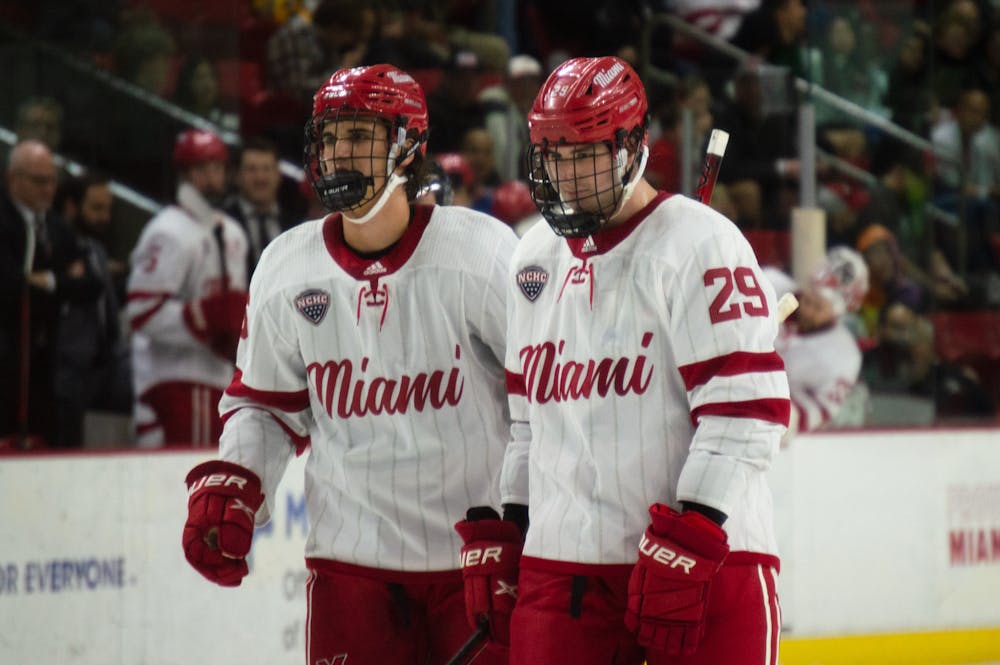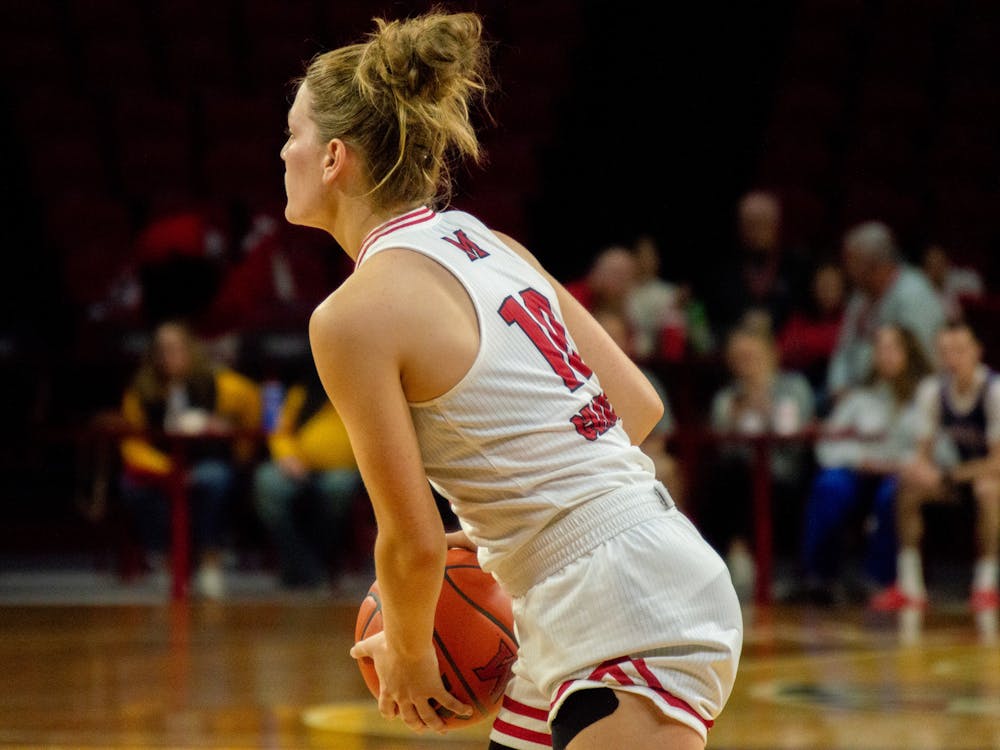Oct. 28, might have been a regular day for many people. However, in the hockey world, that date marked the tragic loss of a beloved former National Hockey League (NHL) player, Adam Johnson.
At just 29 years old, Johnson lost his life playing in the Elite Ice Hockey League (EIHL) after his neck was cut by a skate of opposing player Matt Petgrave. Since the tragedy, players and organizations around hockey have started to emphasize the usage of neck guards.
The Miami University RedHawks hockey program is doing much of the same thing, with players beginning to use neck guards as soon as the incident happened. Equipment manager Andy Geshan is tasked with making specific gear available to players.
“It’s basically just getting a product, providing it and making it available, and then the players decide what they want to do,” Geshan said.
A Miami hockey alumnus provides mock turtlenecks with kevlar material in it through a deal he has with the hockey-based company Warroad. The turtlenecks also have a little bit of kevlar material in the wrists to protect players.
As far as the frequency of these injuries happening, in Geshan’s experience, there have been a multitude of players cut by skate blades. In 2010, defensive player Will Weber was slashed horizontally on the side of his neck below his chin. He cut an artery and required 100 stitches.
After that incident, the team received a neck guard product from the hockey company Bauer. Some players used it for a bit, but it didn’t stick. Geshan has kept the product as a backup option.
“We still have a stock from 2010 of the Bauer product, and we just made it available,” Geshan said. “It was completely optional. Some guys have tried and discontinued its use, and some continue to use it.””
But the job of protecting players goes beyond the equipment manager. It also extends to head coach Chris Bergeron and his staff.
Bergeron is in his fifth season at Miami. He joined the program after the Weber incident occurred, but he understands how serious this issue is.
“The protection of these players is the first and foremost concern we always have,” Bergeron said. “Helmets, gloves, shin guards, all those kinds of things are great, but anyone who knows hockey knows how dangerous the skates and the blades can be, especially to areas that are a little more exposed.”
Enjoy what you're reading?
Signup for our newsletter
In response to the recent death of Johnson, Bergeron believes that the availability of safety equipment should be the primary concern instead of how it looks or feels.
“With this cut-proof stuff available, let’s use it,” Bergeron said. “Why not be overprotective and sacrifice a little bit of comfort to stay protected? Like anything else, you can get used to it. Let’s be proactive. These things are available, so why not protect yourselves and your children from these things happening?”
The next step for some leagues is mandating the usage of neck guards. The current NHL and National Collegiate Hockey Conference (NCHC) policies don’t require neck guards. Shortly after Johnson’s death, the Western Hockey League joined the rest of the Canadian Hockey League in making neck protection mandatory for players during games and practices. USA Hockey, which governs youth hockey in the United States, is expected to implement mandatory neck protection sometime this winter.
When it comes to the Miami hockey team though, the plan is not to mandate neck guard usage.
“We don’t want to learn a hard lesson through tragedy, but we also want to treat them like adults, and that’s where we are right now,” Bergeron said. “We’ve given them all the information. We’ve talked about how to protect themselves, and I want them to protect themselves. We have not made it mandatory to this point.”
According to Bergeron, every player gave the garments a chance at practice the day after they received the equipment.
“When I discussed it with the staff, it wasn’t going to be mandatory, but it was going to be talked about,” Bergeron said. “It was going to be encouraged, and we were going to have pieces for them to use if they chose to use it.”
Even if Miami players are not required to wear them yet, the NCHC still has the option to mandate the use of neck guards for member teams. However, as of now, they have not decided to mandate them, according to a statement from NCHC Commissioner Heather Weems.
“Following the tragedy of Adam Johnson, the Conference confirmed all our member teams are offering neck guards to student-athletes, as well as cut-resistant wrist guards and socks,” Weems wrote in an email to The Miami Student. “While we encourage our student-athletes to use or at least try the neck guards, we are not mandating them at this time. The NCHC will continue to work with the NCAA on all safety matters, including recommendations and policy to maximize player safety.”
Hockey is an inherently dangerous sport, but when something like the Johnson tragedy happens, it still shocks the world. Miami hockey isn’t mandating anything as of yet, but as discussions continue, who knows what the future is regarding protective gear in hockey.




